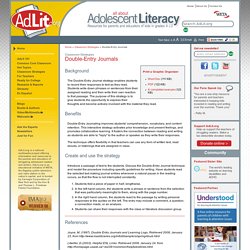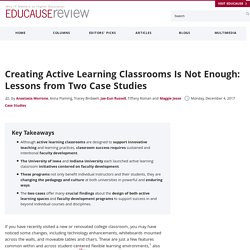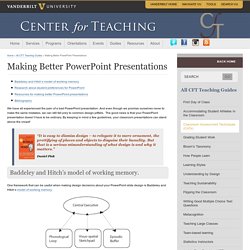

Double-Entry Journals. Classroom Strategies Background The Double-Entry Journal strategy enables students to record their responses to text as they read.

Students write down phrases or sentences from their assigned reading and then write their own reaction to that passage. The purpose of this strategy is to give students the opportunity to express their thoughts and become actively involved with the material they read. Benefits Double-Entry Journaling improves students' comprehension, vocabulary, and content retention.
The technique offers flexibility in that teachers can use any form of written text, read alouds, or listenings that are assigned in class. Create and use the strategy Introduce a passage of text to the students. Students fold a piece of paper in half, lengthwise.In the left hand column, the students write a phrase or sentence from the selection that was particularly meaningful to them, along with the page number. References Joyce, M. (1997). Litwiller, D.(2003). Ruddell, R. (2002). The Active Reviewing Cycle and articles about Active Reviewing. Feedback Methods and how they can be matched to the active reviewing cycle.

This tutorial matches active and creative reviewing methods to the learning cycle. You are welcome to try it out - for free! Please let me know how you get on! Write to: roger@reviewing.co.uk Once you have tried out the tutorial, use the links below to learn more about active reviewing. Teaching. How to Hold a Better Class Discussion. Snowball discussion technique. COPUS Analyzer - COPUS Profiles. Center for Teaching & Learning. Active Learning Strategies help to initiate learners and instructors into effective ways to help everyone engage in activities based on ideas about how people learn. Multiple active learning strategies may be used in each of the active learning designs. Review an annotated list of active learning strategies 1. Sit & talk with peers nearby Think-Pair- Share. 1. Center for Teaching and Learning.
Creating Active Learning Classrooms Is Not Enough: Lessons from Two Case Studies. Key Takeaways.

Adaptive Learning at Western University of Health Sciences. Learning Styles. By Nancy Chick, CFT Assistant Director What are Learning Styles?

| Caution! | Why Are They So Popular? | Now What? What are Learning Styles? The term learning styles is widely used to describe how learners gather, sift through, interpret, organize, come to conclusions about, and “store” information for further use. There are well over 70 different learning styles schemes (Coffield, 2004), most of which are supported by “a thriving industry devoted to publishing learning-styles tests and guidebooks” and “professional development workshops for teachers and educators” (Pashler, et al., 2009, p. 105).
Despite the variation in categories, the fundamental idea behind learning styles is the same: that each of us has a specific learning style (sometimes called a “preference”), and we learn best when information is presented to us in this style. Making Better PowerPoint Presentations. Home » All CFT Teaching Guides » Making Better PowerPoint Presentations We have all experienced the pain of a bad PowerPoint presentation.

And even though we promise ourselves never to make the same mistakes, we can still fall prey to common design pitfalls. The good news is that your PowerPoint presentation doesn’t have to be ordinary. By keeping in mind a few guidelines, your classroom presentations can stand above the crowd! “It is easy to dismiss design – to relegate it to mere ornament, the prettifying of places and objects to disguise their banality.
Baddeley and Hitch’s model of working memory. One framework that can be useful when making design decisions about your PowerPoint slide design is Baddeley and Hitch’s model of working memory. As illustrated in the diagram above, the Central Executive coordinates the work of three systems by organizing the information we hear, see, and store into working memory. The Phonological Loop deals with any auditory information. Bibliography. Curriculum Inventory and Reports (CIR) - Initiatives. California State University, Los Angeles.
Getting Started – Splashtop for Education - Support. Splashtop Classroom allows teachers to control and annotate over their desktop and applications from anywhere in the classroom.

Even better, teachers can share their computer screen with their students’ devices and allow students to collaborate directly from their own devices. Splashtop Classroom is perfect for teachers and instructors who want to engage the entire room! Log in with your Splashtop account at to start a free trial or buy a subscription. (If you don't already have a Splashtop account, click on 'Create Splashtop Account')Go to the Account Info-> Subscriptions tab to subscribe to Splashtop Classroom.Follow the instructions at to start a session. On your PC/Mac: Download and install Streamer (v2.6.0.0+) on the PC/Mac you want to share.Sign in with your Splashtop account on the Streamer Status tab. On your iPad or Android device:
Splashtop Downloads. Log in. A Guide to Teaching in the Active Learning Classroom. The Center for Educational Innovation is excited to announce the publication of A Guide to Teaching in the Active Learning Classroom: History, Research, and Practice, coauthored by D.

Christopher Brooks, Kem Saichaei, and CEI staff members Paul Baepler, Christina Petersen, and JD Walker. With the construction of Bruininks Hall and its large inventory of Active Learning Classrooms (ALCs), the University of Minnesota has been presented with an incredible opportunity to reinvent classroom teaching. For several years, Minnesota instructors have been on the forefront of working in these new learning environments, and this new book, A Guide to Teaching in the Active Learning Classroom: History, Research, and Practice, draws on their experience as well as the research conducted in UM classrooms.
"This book delivers exactly what is promised by the title. It is full of practical advice but also includes pointers to the research those teaching methods are based upon. A Guide to Teaching in the Active Learning Classroom.